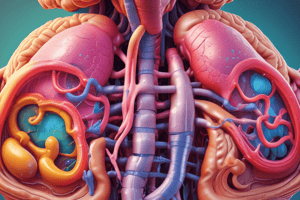Podcast
Questions and Answers
What is the main function of the esophagus in the human digestive system?
What is the main function of the esophagus in the human digestive system?
- Mixing food with saliva
- Breaking down food using enzymes
- Preventing stomach contents from flowing back (correct)
- Absorption of nutrients
Which organ secretes gastric juices containing hydrochloric acid in the digestive system?
Which organ secretes gastric juices containing hydrochloric acid in the digestive system?
- Stomach (correct)
- Gallbladder
- Liver
- Pancreas
What is the role of saliva in the digestive process?
What is the role of saliva in the digestive process?
- Regulating stomach acid
- Starting the breakdown of carbohydrates (correct)
- Absorbing nutrients
- Breaking down proteins
What is the function of the villi in the small intestine?
What is the function of the villi in the small intestine?
Which part of the digestive system starts the breakdown of carbohydrates?
Which part of the digestive system starts the breakdown of carbohydrates?
Which organ produces bile to aid in fat digestion?
Which organ produces bile to aid in fat digestion?
What is the function of the lower esophageal sphincter in the digestive system?
What is the function of the lower esophageal sphincter in the digestive system?
Which organ in the digestive system responds to the presence of food by secreting gastric juices?
Which organ in the digestive system responds to the presence of food by secreting gastric juices?
What is the main responsibility of the large intestine?
What is the main responsibility of the large intestine?
Which part of the colon is responsible for connecting the small intestine to the rectum?
Which part of the colon is responsible for connecting the small intestine to the rectum?
What is the role of gut flora in the digestive system?
What is the role of gut flora in the digestive system?
How does the nervous system contribute to the digestive process?
How does the nervous system contribute to the digestive process?
Study Notes
Human Digestive System Functions and Adaptations
The human digestive system is a complex network of organs, glands, and nerves that work together to break down food and absorb nutrients. It is a long, twisting tube that starts at the mouth and ends at the anus, including the esophagus, stomach, small intestine, large intestine, pancreas, liver, and gallbladder. The system is designed to extract essential nutrients from food, such as proteins, fats, carbohydrates, vitamins, and minerals, which are then absorbed into the bloodstream and transported to different parts of the body for energy, growth, and repair.
Functions of the Digestive System
Mouth and Oral Structures
The digestive process begins in the mouth, where food is chewed using teeth and mixed with saliva, which contains enzymes that start breaking down carbohydrates. The tongue helps in kneading the food and mixing it with saliva.
Esophagus
The esophagus is a muscular tube that carries food from the mouth to the stomach. A ring of muscle at the end of the esophagus, called the lower esophageal sphincter, prevents stomach contents from flowing back into the esophagus.
Stomach
The stomach is a saclike organ that breaks down food using gastric juices, which contain hydrochloric acid and enzymes. The stomach secretes these juices in response to the presence of food, and the churning and grinding motion of the stomach walls further break down the food.
Small Intestine
The small intestine is the longest part of the GI tract and is responsible for most of the nutrient absorption. It is lined with tiny finger-like projections called villi, which increase the surface area for nutrient absorption. The pancreas and liver also contribute enzymes and bile, respectively, to the small intestine to aid in digestion and absorption.
Large Intestine and Colon
The large intestine is responsible for water and electrolyte absorption and the formation of stool. The colon is a muscular tube that connects the small intestine to the rectum, and it is made up of the cecum, ascending, transverse, descending, and sigmoid colon.
Liver, Pancreas, and Gallbladder
The liver processes nutrients absorbed from the small intestine, produces bile to aid in fat digestion, and detoxifies potentially harmful substances. The pancreas secretes digestive enzymes into the duodenum and produces insulin, while the gallbladder stores and concentrates bile from the liver, releasing it into the duodenum to aid in fat digestion.
Adaptations of the Digestive System
Gastrointestinal Tract
The gastrointestinal tract is a long, twisting tube designed to handle different types of food and liquids. Its length and shape allow for efficient mixing and digestion of food, as well as adaptation to changes in food composition.
Nervous and Circulatory Systems
The digestive system is interconnected with the nervous and circulatory systems, which help control the digestive process. Nerves and hormones regulate the contraction and relaxation of the muscles in the walls of the organs, controlling the movement of food through the tract.
Bacteria
The human digestive system contains a diverse community of bacteria, known as gut flora or microbiome, which aid in digestion and maintain a balance of beneficial microorganisms.
In conclusion, the human digestive system is a complex and efficient system that converts food into nutrients, which are then absorbed and used by the body for energy, growth, and repair. Its structures and functions are highly adapted to handle a wide range of food and fluids, and it is interconnected with other systems in the body to maintain overall health.
Studying That Suits You
Use AI to generate personalized quizzes and flashcards to suit your learning preferences.
Description
Test your knowledge about the functions and adaptations of the human digestive system, from the mouth to the large intestine and associated organs such as the liver, pancreas, and gallbladder. Learn about nutrient absorption, mechanical digestion, and the role of bacteria in the digestive process.




